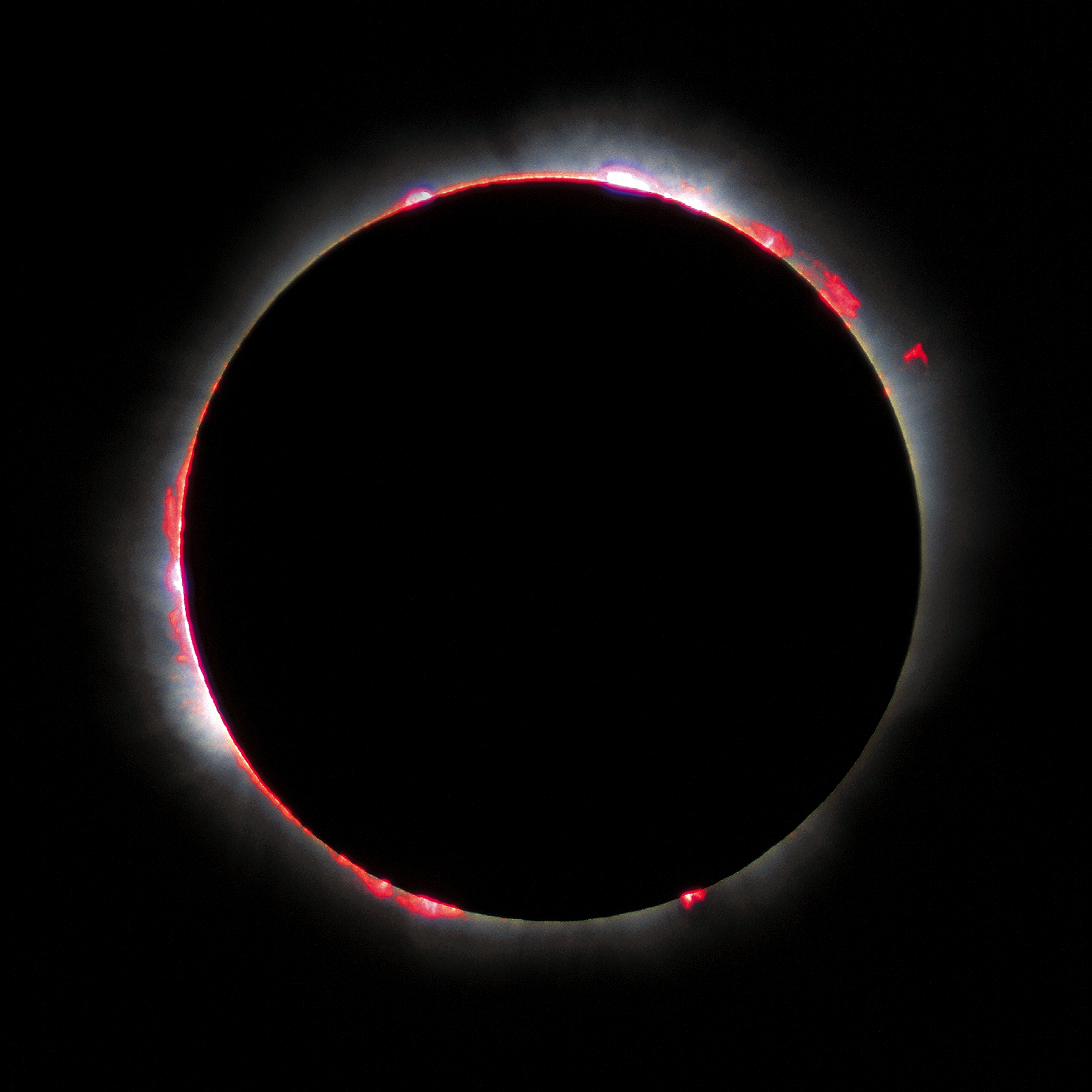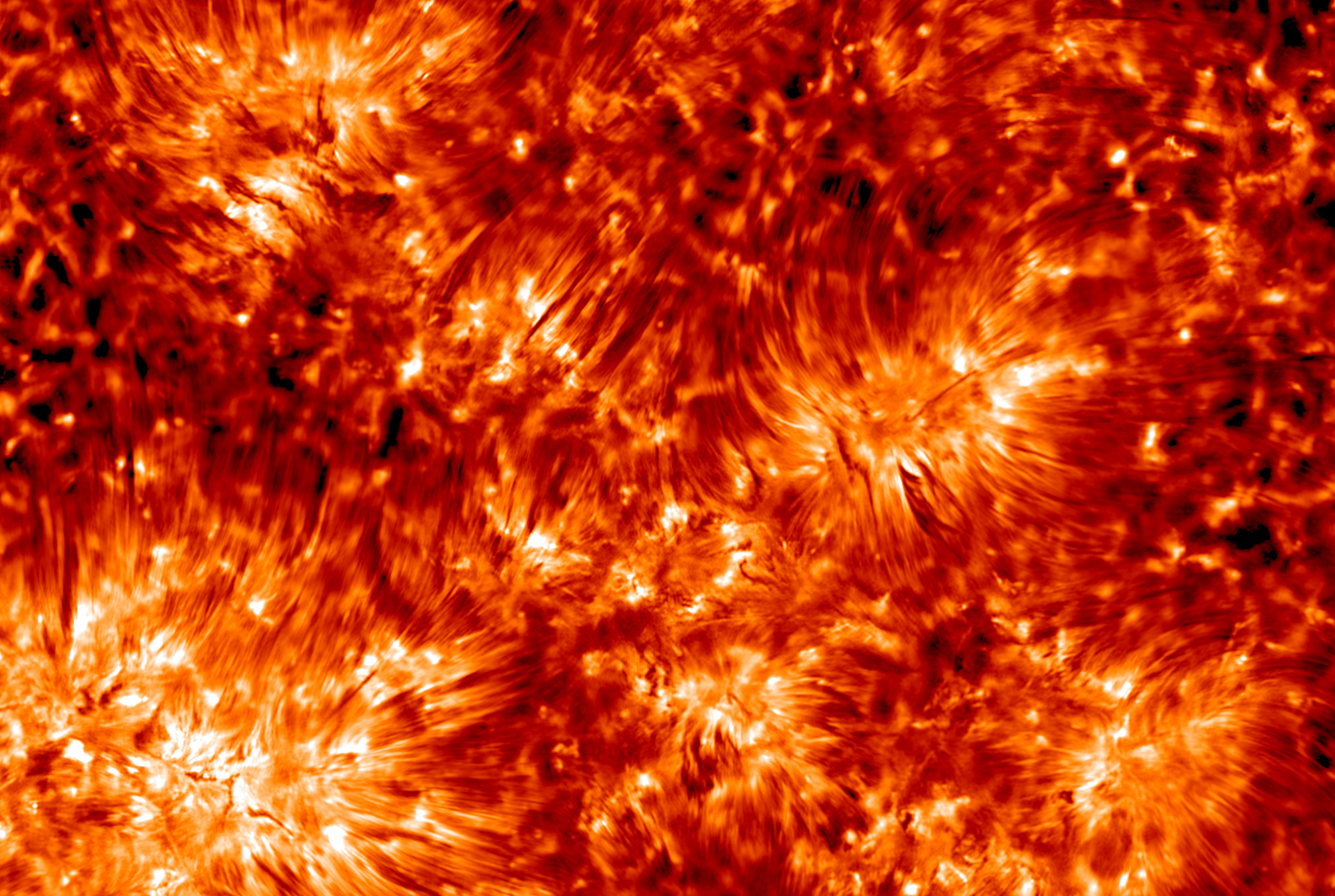photosphere
The photosphere is a star's outer shell from which light is radiated.
The term itself is derived from Ancient Greek roots, φῶς, φωτός/''phos, photos'' meaning "light" and σφαῖρα/''sphaira'' meaning "sphere", in reference to it ...
and below the solar transition region and corona. The term usually refers to the Sun's chromosphere, but not exclusively.
In the Sun's atmosphere
The Sun is the star at the center of the Solar System. It is a nearly perfect ball (mathematics), ball of hot plasma (physics), plasma, heated to incandescence by nuclear fusion reactions in its core. The Sun radiates this energy mainly as ...
, the chromosphere is roughly in height, or slightly more than 1% of the Sun's radius at maximum thickness. It possesses a homogeneous layer at the boundary with the photosphere. Hair-like jets of plasma, called spicules
Spicules are any of various small needle-like anatomical structures occurring in organisms
Spicule may also refer to:
* Spicule (sponge), small skeletal elements of sea sponges
* Spicule (nematode), reproductive structures found in male nematodes ...
, rise from this homogeneous region and through the chromosphere, extending up to into the corona above.
The chromosphere has a characteristic red color due to electromagnetic emission
In physics, electromagnetic radiation (EMR) consists of waves of the electromagnetic (EM) field, which propagate through space and carry momentum and electromagnetic radiant energy. It includes radio waves, microwaves, infrared, (visible) ligh ...
s in the ''H''α spectral line
A spectral line is a dark or bright line in an otherwise uniform and continuous spectrum, resulting from emission or absorption of light in a narrow frequency range, compared with the nearby frequencies. Spectral lines are often used to iden ...
. Information about the chromosphere is primarily obtained by analysis of its emitted electromagnetic radiation.
Chromospheres have also been observed on star
A star is an astronomical object comprising a luminous spheroid of plasma held together by its gravity. The nearest star to Earth is the Sun. Many other stars are visible to the naked eye at night, but their immense distances from Earth make ...
s other than the Sun. On large stars, chromospheres sometimes make up a significant proportion of the entire star. For example, the chromosphere of supergiant star Antares has been found to be about 2.5 times larger in thickness than the star's radius.
Physical properties
 The density of the Sun's chromosphere decreases exponentially with distance from the center of the Sun by a factor of roughly 10 million, from about at the chromosphere's inner boundary to under at the outer boundary. The temperature initially decreases from the inner boundary at about to a minimum of approximately , but then increasing to upwards of at the outer boundary with the transition layer of the corona (see ).
The density of the chromosphere is 10−4 times that of the underlying
The density of the Sun's chromosphere decreases exponentially with distance from the center of the Sun by a factor of roughly 10 million, from about at the chromosphere's inner boundary to under at the outer boundary. The temperature initially decreases from the inner boundary at about to a minimum of approximately , but then increasing to upwards of at the outer boundary with the transition layer of the corona (see ).
The density of the chromosphere is 10−4 times that of the underlying photosphere
The photosphere is a star's outer shell from which light is radiated.
The term itself is derived from Ancient Greek roots, φῶς, φωτός/''phos, photos'' meaning "light" and σφαῖρα/''sphaira'' meaning "sphere", in reference to it ...
and 10−8 times that of the Earth's atmosphere
The atmosphere of Earth is the layer of gases, known collectively as air, retained by Earth's gravity that surrounds the planet and forms its planetary atmosphere. The atmosphere of Earth protects life on Earth by creating pressure allowing f ...
at sea level. This makes the chromosphere normally invisible and it can be seen only during a total eclipse, where its reddish colour is revealed. The colour hues are anywhere between pink and red.
Without special equipment, the chromosphere cannot normally be seen due to the overwhelming brightness of the photosphere.
The chromosphere's spectrum
A spectrum (plural ''spectra'' or ''spectrums'') is a condition that is not limited to a specific set of values but can vary, without gaps, across a continuum. The word was first used scientifically in optics to describe the rainbow of color ...
is dominated by emission lines. In particular, one of its strongest lines is the ''H''α at a wavelength
In physics, the wavelength is the spatial period of a periodic wave—the distance over which the wave's shape repeats.
It is the distance between consecutive corresponding points of the same phase on the wave, such as two adjacent crests, tr ...
of ; this line is emitted by a hydrogen atom
A hydrogen atom is an atom of the chemical element hydrogen. The electrically neutral atom contains a single positively charged proton and a single negatively charged electron bound to the nucleus by the Coulomb force. Atomic hydrogen cons ...
whenever its electron
The electron (, or in nuclear reactions) is a subatomic particle with a negative one elementary electric charge. Electrons belong to the first generation of the lepton particle family,
and are generally thought to be elementary partic ...
makes a transition from the ''n''=3 to the ''n''=2 energy level
A quantum mechanical system or particle that is bound—that is, confined spatially—can only take on certain discrete values of energy, called energy levels. This contrasts with classical particles, which can have any amount of energy. The ...
. A wavelength of is in the red part of the spectrum, which causes the chromosphere to have a characteristic reddish colour.
Chromospheric phenomena
 Many different phenomena can be observed in chromospheres.
Many different phenomena can be observed in chromospheres.
Plage
A plage is a particularly bright region within stellar chromospheres, which are often associated with magnetic activity.Spicules
The most commonly identified feature in the solar chromosphere are spicules. Spicules rise to the top of the chromosphere and then sink back down again over the course of about 10 minutes.Oscillations
Since the first observations with the instrument SUMER on boardSOHO
Soho is an area of the City of Westminster, part of the West End of London. Originally a fashionable district for the aristocracy, it has been one of the main entertainment districts in the capital since the 19th century.
The area was develo ...
, periodic oscillations in the solar chromosphere have been found with a frequency from to , corresponding to a characteristic periodic time of three minutes. Oscillations of the radial component of the plasma velocity are typical of the high chromosphere. The photospheric granulation pattern usually has no oscillations above ; however, higher frequency waves (, or a period) were detected in the solar atmosphere (at temperatures typical of the transition region and corona) by TRACE.
Chromospheric loops
Plasma loops can be seen at the border of the solar disk in the chromosphere. They are different fromsolar prominences
A prominence, sometimes referred to as a filament, is a large plasma and magnetic field structure extending outward from the Sun's surface, often in a loop shape. Prominences are anchored to the Sun's surface in the photosphere, and extend outw ...
because they are concentric arches with maximum temperature of the order (too low to be considered coronal features). These cool-temperature loops show an intense variability: they appear and disappear in some UV lines in a time less than an hour, or they rapidly expand in 10–20 minutes. Foukal studied these cool loops in detail from the observations taken with the EUV spectrometer on Skylab
Skylab was the first United States space station, launched by NASA, occupied for about 24 weeks between May 1973 and February 1974. It was operated by three separate three-astronaut crews: Skylab 2, Skylab 3, and Skylab 4. Major operation ...
in 1976. When the plasma temperature of these loops becomes coronal (above ), these features appear more stable and evolve over longer times.
Chromospheric network
Images taken in typical chromospheric lines show the presence of brighter cells, usually referred to as the ''network'', while the surrounding darker regions are named ''internetwork''. They look similar to granules commonly observed on the photosphere due to the heatconvection
Convection is single or multiphase fluid flow that occurs spontaneously due to the combined effects of material property heterogeneity and body forces on a fluid, most commonly density and gravity (see buoyancy). When the cause of the c ...
.
Stellar chromospheres
Chromospheres are present on almost all luminous stars other thanwhite dwarf
A white dwarf is a stellar core remnant composed mostly of electron-degenerate matter. A white dwarf is very dense: its mass is comparable to the Sun's, while its volume is comparable to the Earth's. A white dwarf's faint luminosity comes ...
s. They are most prominent and magnetically active on lower- main sequence stars, on brown dwarf
Brown dwarfs (also called failed stars) are substellar objects that are not massive enough to sustain nuclear fusion of ordinary hydrogen (hydrogen-1, 1H) into helium in their cores, unlike a main sequence, main-sequence star. Instead, they have ...
s of F and later spectral types, and on giant
In folklore, giants (from Ancient Greek: '' gigas'', cognate giga-) are beings of human-like appearance, but are at times prodigious in size and strength or bear an otherwise notable appearance. The word ''giant'' is first attested in 1297 fr ...
and subgiant stars.
A spectroscopic measure of chromospheric activity on other stars is the Mount Wilson S-index.gives "Wright J. T., Marcy G. W., Butler R. P., Vogt S. S., 2004, ApJS, 152, 261" as a ref for s-index.
See also
*Orders of magnitude (density)
Density (volumetric mass density or specific mass) is the substance's mass per unit of volume. The symbol most often used for density is ''ρ'' (the lower case Greek letter rho), although the Latin letter ''D'' can also be used. Mathematically ...
* Moreton wave
References
External links
Animated explanation of the Chromosphere (and Transition Region)
(University of South Wales).
(University of South Wales). {{Authority control Sun